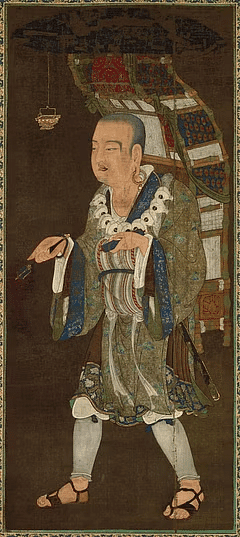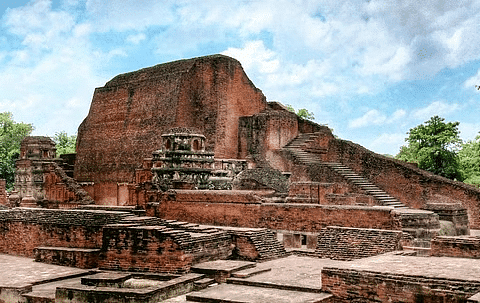Old NCERT Summary (RS Sharma): Harsha and His Times | History for UPSC CSE PDF Download
| Table of contents |

|
| Harsha and His Kingdom |

|
| Administration |

|
| Hsuan Tsang's Account |

|
| Buddhism and Nalanda |

|
Harsha and His Kingdom
During the time of the Chinese pilgrim, the Buddhists were split into 18 sects. The renowned Nalanda centre of Buddhism faced challenges. Nalanda housed a significant Buddhist university, teaching the Mahayana school philosophy to about 10,000 monk students over 700 years. Excavations revealed impressive buildings, but the capacity did not match the reported number of monks.
Harsha, initially a Saiva, evolved into a strong supporter of Buddhism. He organised a grand assembly at Prayag attended by nobility. The assembly included worship of a Buddha image and discourses by the Chinese pilgrim Hsuan Tsang. Harsha made substantial charitable contributions at the end. His tolerant religious policy allowed the pilgrim to visit different parts of the empire.
 Harsha's Empire
Harsha's Empire
Harsha, beyond his political role, was a literary figure, having written three plays. He supported literary individuals, and Banabhatta depicted his early patronage in the ornate style of Harshacharita.
Administration
Harsha governed his empire following the Gupta administrative model, albeit with increased feudal and decentralized characteristics. Records suggest that Harsha possessed a substantial military force:
- It had a boasting 100,000 horses and 60,000 elephants. This figure appears remarkable when compared to the Mauryas;
- Mauryas who, despite ruling most of the country except the deep south, maintained only 30,000 cavalry and 9,000 elephants.
- Harsha's ability to mobilize support from all his feudatories during wartime allowed him to amass a larger army, with each feudatory contributing foot soldiers and horses, thereby significantly enlarging the imperial forces.
Similar to previous practices, land grants continued to be awarded to priests for their services to the state. Harsha is also acknowledged for granting land to officers through charters, providing them with similar concessions as earlier grants.
According to Chinese pilgrim Hsuan Tsang, Harsha's revenues were divided into four parts: one for the king's expenditure, another for scholars, a third for officials and public servants, and a fourth for religious purposes. Ministers and high-ranking state officers were endowed with land, marking the beginning of the feudal practice of rewarding officers with land grants, possibly due to a scarcity of coins issued by Harsha.
In terms of law and order, Harsha's empire faced challenges. Hsuan Tsang, despite potentially receiving special attention from the government, reported being robbed, highlighting a lack of effective security. While severe punishments were prescribed by law, such as amputating the right hand for robbery, the influence of Buddhism led to a more lenient approach, with some criminals receiving life imprisonment instead of harsh physical penalties.
Hsuan Tsang's Account
The era of Harsha is noteworthy due to the visit of the Chinese pilgrim Hsuan Tsang, who departed from China in AD 629 and journeyed all the way to India. After an extended stay in India, he returned to China in AD 645. Hsuan Tsang came to study at the Buddhist university of Nalanda, located in the district of the same name in Bihar, and to collect Buddhist texts from India. Spending numerous years at Harsha's court and extensively traveling across India, the pilgrim provides a vivid description of Harsha's court, offering insights into the economic, social life, and religious sects of the period.
According to the Chinese account;
- Pataliputra was in a state of decline, as was Vaisali. In contrast, Prayag and Kanauj in the doab had gained importance.
- Brahmanas and Kshatriyas are noted to have led a simple life, while the nobles and priests enjoyed a luxurious lifestyle. Hsuan Tsang refers to the Sudras as agriculturists, a significant shift from earlier texts where they were depicted as serving the three higher varnas.
- He also observes untouchables, including scavengers and executioners, who lived outside the villages and consumed garlic and onions. The untouchables would announce their entry into the town loudly to ensure people kept a distance from them.
 Hsuan Tsang
Hsuan Tsang
Buddhism and Nalanda
During the time of the Chinese pilgrim, the Buddhists were split into 18 sects. The renowned Nalanda centre of Buddhism faced challenges. Nalanda housed a significant Buddhist university, teaching the Mahayana school philosophy to about 10,000 monk students over 700 years. Excavations revealed impressive buildings, but the capacity did not match the reported number of monks.
Harsha, initially a Saiva, evolved into a strong supporter of Buddhism. He organised a grand assembly at Prayag attended by nobility. The assembly included worship of a Buddha image and discourses by the Chinese pilgrim Hsuan Tsang. Harsha made substantial charitable contributions at the end. His tolerant religious policy allowed the pilgrim to visit different parts of the empire.
Harsha, beyond his political role, was a literary figure, having written three plays. He supported literary individuals, and Banabhatta depicted his early patronage in the ornate style of Harshacharita.
 Present Remains of Nalanda University
Present Remains of Nalanda University
|
216 videos|855 docs|219 tests
|
FAQs on Old NCERT Summary (RS Sharma): Harsha and His Times - History for UPSC CSE
| 1. Who was Harsha and what was his kingdom? |  |
| 2. What is the significance of Hsuan Tsang's account in understanding Harsha's reign? |  |
| 3. What role did Buddhism play during Harsha's reign? |  |
| 4. What is the significance of Nalanda in relation to Harsha and Buddhism? |  |
| 5. What does the old NCERT book by RS Sharma provide in terms of understanding Harsha and his times? |  |
















